31 - Lymph Nodes
Editors: Mills, Stacey E.
Title: Histology for Pathologists, 3rd Edition
Copyright 2007 Lippincott Williams & Wilkins
> Table of Contents > X - Female Genital System > 39 - Vulva
39
Vulva
Edward J. Wilkinson
Nancy S. Hardt
Clinical Perspective
Vulvar symptoms are a common cause of clinical visits to gynecologists and family practitioners. Complaints may include pruritus, burning, external dyspareunia, and a visible or palpable mass (1,2). The majority of sexually transmitted infections, as well as many granulomatous and dermatological diseases, may involve the vulva (2,3,4). Graft-versus-host disease (5) and contact dermatitis (6,7) may create symptoms requiring evaluation of the vulva and vagina. The vulva (pudendum femininum) is also a crucial area for detailed examination in cases of reported rape, sexual abuse, or female circumcision (8). Ambiguous genitalia and genital anomalies challenge the clinician and demand critical examination of the patient and the external genitalia. Clitoral enlargement in the newborn resulting from adrenal genital syndrome, maternal exposure to exogenous androgens, maldevelopment of the clitoris, benign tumors, and other conditions, such as the Lawrence-Seip syndrome (3,9,10), may result in ambiguous-appearing external genitalia. Clitoromegaly may occur in adulthood due to malignancy or endocrinopathy (11).
Surgical approaches to vulvar diseases are evolving as a result of better understanding of vulvar anatomy and sexual function. Clitoral specimens are submitted less frequently in cases of infant genital ambiguity now that follow-up studies have indicated that permanent loss of function and sensation may result (12,13,14,15,16). In radical surgery for carcinoma of the vulva, the clitoris may be surgically spared if clinical examination does not indicate tumor involvement of that structure (17). The techniques for sentinel node evaluation used in other cancers are now applied to carcinomas of the vulva, permitting removal of less normal tissue from lymph node drainage fields (18,19,20).
Cytologic evaluation of the vulva may complement biopsy in special cases such as extramammary Paget's disease (21) and distinguishing disorders that may clinically resemble Paget's disease (22).
Special Techniques in Clinical Evaluation
Direct examination of the vulva requires adequate illumination and is enhanced by the use of a ring light or magnifying glass (23). The use of higher magnification, using a colposcope, enhances the identification of small condyloma acuminatum, vestibular papillae, vulvar intraepithelial neoplasia and superficial lacerations, microulcerations, and contusions after sexual assault (24). In cases in which
P.984
condyloma acuminatum or vulvar intraepithelial neoplasia is suspected, the use of 3% acetic acid (white vinegar) is of value. Gauze sponges soaked in acetic acid are applied for approximately five minutes, followed by prompt examination. The principle of this technique is that abnormal epithelium, especially condyloma acuminatum and vulvar intraepithelial neoplasia, becomes white immediately after exposure to acetic acid. This is related to poorly understood differences between normal epithelium and human papillomavirus associated lesions. The color change to white after application of the dilute acetic acid is referred to as aceto-whitening, and the epithelium so changed is referred to as aceto-white epithelium. This procedure has gained wide acceptance in the evaluation of the cervical transformation zone during colposcopic examination to enhance identification of cervical intraepithelial neoplasia and carcinoma. However, its use on the vulva has two serious limitations. First, when ulcers or fissures are present on the vulva, the application of 3% acetic acid may be associated with pain and thus is unacceptable to the patient. Second, the vulvar vestibular epithelium is normally somewhat aceto-white. The inexperienced clinician may misinterpret this aceto-whitening as abnormal or as condyloma acuminatum. A biopsy is then performed of the vestibular epithelium and submitted as condyloma acuminatum. The vestibular epithelium in women of reproductive age is normally glycogenated (see section on Vulvar Vestibule) and can be misinterpreted by the unwary pathologist as koilocytosis suggestive of condyloma acuminatum, resulting in both improper diagnosis and improper therapy for the patient. Inflammation within the vestibule may be associated with epithelial spongiosis, which also may be confused with koilocytosis.
The use of 1% toluidine blue O also has been used to assist in the recognition of areas requiring biopsy when invasive carcinoma is suspected (23). A solution of 1% toluidine blue O is applied to the areas in question, which then are rinsed with 1% acetic acid. Areas with ulceration, parakeratosis, and carcinomas without a keratinized surface retain the blue stain. In principle, toluidine blue O is a DNA stain, and as such it is retained where cell nuclei are present (3,23). This test has limited usefulness in that false-positive staining patterns occur, usually due to benign superficial ulceration or fissures. The test may be falsely negative when the carcinoma or intraepithelial neoplasm has a keratinized surface. For these reasons, the test is no longer commonly used.
In addition to direct visualization techniques, imaging studies are increasingly applied in the vulvar assessment of female sexual response and have increased our understanding of the three-dimensional anatomy of that region. These include duplex Doppler ultrasound (25) and magnetic resonance imaging (26,27,28)
From the pathologist's perspective, the majority of vulvar specimens that are examined are either diagnostic biopsies, excisional biopsies, or partial superficial or deep, or total superficial or deep vulvectomy specimens submitted as treatment for vulvar intraepithelial neoplasia, Paget's disease, carcinoma, melanoma, and other diseases (3). An understanding of the normal histology of the vulva enhances interpretive skills and assists in arriving at an appropriate diagnosis.
Anatomy
The female external genitalia can be defined as that portion of the female anatomy external to the hymen, extending anteriorly to include the mons pubis, posteriorly to the anus, and laterally to the inguinal gluteal folds. Included are the mons pubis, clitoris, labia minora, labia majora, vulvar vestibule and vestibulovaginal bulbs, urethral meatus, hymen, Bartholin's and Skene's glands and ducts, and vaginal introitus (Figure 39.1). The anterior investment of the clitoris includes the prepuce, which represents the anterior fusion of the labia minora and overlays the clitoris anteriorly, and the frenulum, which passes posteriorly and ends in its attachment to the flattened posterior aspect of the clitoris. Posteriorly, the labia minora end in the fourchette, or frenulum of the labia. The labia majora lie lateral to the intralabial sulcus and medial to the inguinal-gluteal fold. Anteriorly, the hair-bearing lateral aspects of the labia majora blend with the mons pubis, and posteriorly, the labia majora end in the perineal body. The hair follicles of the labia majora are absent in its medial portion; however, the sebaceous gland elements are retained medial and posterior to the labia minora at the junction with the vulvar vestibule at Hart's line (29,30) (Figure 39.2).
P.985
These sebaceous gland elements open directly to the epithelial surface in this portion of the vulva and can be observed as small, slightly pale to yellow elevations of the epithelium, known as Fordyce's spots.
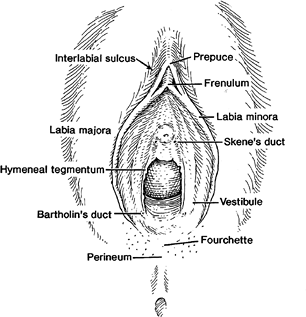 |
Figure 39.1 Topography of the vulva. |
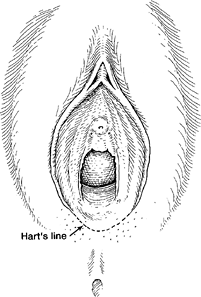 |
Figure 39.2 The vulvar vestibule and the position of Hart's line. Hart's line can be found on the medial aspect of the labia majora, extending in a curvilinear manner from the most inferior posterior portion of the labia minora to the vaginal fourchette. |
Normal vulvar epithelium varies in thickness from 0.27 0.14 mm. When involved by vulvar intraepithelial neoplasia, the thickness of the epithelium with vulvar intraepithelial neoplasia (VIN) is reported from 0.52 0.23 mm (31). The vulvar epithelium, especially that of the lateral labia minora, labia majora, and perineal body, contains melanocytes that are distributed among the basal cells of the epithelium in a ratio from 1:5 to 1:10 basal keratinocytes (32). Increased pigmentation of these areas during pregnancy relate to increased melanin production secondary to the effects of gestational hormones.
Langerhans cells are relatively abundant in the vulvar epithelium, where they are more prevalent than within the vagina or cervix. They are present predominantly in the suprabasal layers of vulvar epithelium, with a median number of 18.7 per 100 basal squamous cells (33). They are present in keratinized and nonkeratinized epithelium, as well as within skin appendages. These dendritic cells are bone marrow derived and can express HLA-DR antigens and Fc and C3 receptors and are capable of activating T lymphocytes as an afferent component of the immune response of the vulvar epithelium (34). Langerhans cells are also thought to be associated with control of keratinocyte maturation (35). The topical T-lymphocyte inhibitor, pimecrolimus, has recently been used to effectively treat vulvar lichen sclerosus in a 10-year-old girl. Lichen sclerosus is a dermatosis that is considered to be T-lymphocyte mediated (36).
Merkel cells are neuroendocrine cells that are present in vulvar epithelium, as well as most other skin sites. These cells are involved in paracrine regulation of skin function (37). Merkel cell tumors of the vulva have been reported (38).
Lymphocytes are also commonly found in the dermis and submucosal areas of the vulva in small numbers and are located primarily in a perivascular area within the superficial tissues. Intraepithelial lymphocytes are infrequently seen in normal vulvar epithelium (33).
Vulvar Vestibule
The vulvar vestibule is defined as that portion of the vulva that extends from the exterior surface of the hymen to the frenulum of the clitoris anteriorly, the fourchette posteriorly, anterolaterally to the labia minora, and posterolaterally to Hart's line, on the medial aspects of the labia majora (Figures 39.1,39.2). The vestibular fossa (fossa navicularis) is that posterior portion of the vestibule, from the hymen to the fourchette, that is somewhat concave as compared with the remainder of the vestibule. Unlike the remainder of the vulvar epithelium, which is of ectodermal origin, the epithelium of the vulvar vestibule is of endodermal origin. One exception is the portion of the vulvar vestibular epithelium anterior to the urethra, which some think is of ectodermal origin (39). The vulvar vestibule is predominantly nonkeratinized stratified squamous epithelium, which peripherally blends with the thinly keratinized squamous epithelium of the labia minora, the medial labia majora at Hart's line, the prepuce, and the fourchette. Although the vestibular epithelium has an embryonic origin similar to that of the distal urethra of the male, the epithelium is not of a typical transitional type with associated surface umbrella cells. Rather, it is a stratified squamous epithelium that is rich in glycogen in women of reproductive age, similar to the mucosa of the vagina and ectocervix (Figure 39.3).
Both the vaginal opening and the urethral orifice are within the vestibule. Also within the vulvar vestibule are gland openings from both the major and minor vestibular glands, as well as the paired opening of the periurethral Skene's ducts. Skene's ducts are the homologues of the male prostate gland. The major vestibular gland, or Bartholin's gland (glandula vestibularis major), is of ectodermal origin and consists of bilateral tubuloalveolar glands located beneath the hymen, labia minora, and labia majora in the posteriolateral area of the vulva. Bartholin's gland corresponds to the male bulbourethral glands, or Cowper's glands. The epithelial cells of Bartholin's gland acini consist of mucus-secreting columnar cells (40,41) (Figure 39.4). The secretion of these acini empty into Bartholin's duct, which measures approximately 2.5 cm in length and enters the vestibule immediately exterior (distal) and adjacent to the hymen in a posterolateral location. Bartholin's duct is lined by transitional epithelium
P.986
that is adjacent to columnar epithelium as it arises from the gland (Figure 39.5) to adjoin the nonkeratinized stratified squamous epithelium of the vulvar vestibule in the distal end of the duct (41) (Figure 39.6). Within the Bartholin duct epithelium, argentaffin cells also can be identified, predominantly concentrated within the transitional ductal epithelial cell area and absent in the secretory gland area (42). Cysts that arise in the area of Bartholin's gland are primarily a result of dilation of Bartholin's duct (3,43).
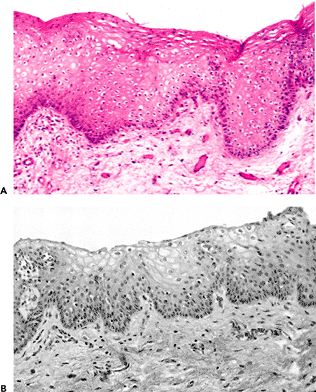 |
Figure 39.3 A. Vulvar vestibule with adjacent prominent vascular submucosa. Superficial thin-walled vessels are prominent and are found within the delicate fibrous stroma. A few lymphocytes are seen scattered in the superficial submucosa. B. Epithelium of the vulvar vestibule of a 27-year-old woman. Note that the epithelium is stratified squamous and that the superficial cells have cytoplasmic clearing, reflecting the glycogen-rich epithelium. |
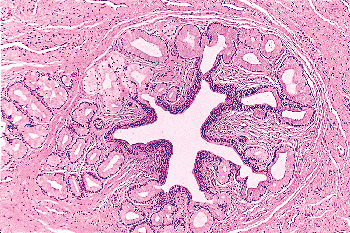 |
Figure 39.4 Bartholin's gland acini are lined with a columnar epithelium. The adjacent branching Bartholin's duct is present adjacent to the gland. |
The periurethral, or Skene's, glands also enter the vulvar vestibule as paired gland openings found immediately adjacent to and posterolateral to the urethra. These glands, with their adjacent ducts, are generally not more than 1.5 cm in length. These periurethral glands are analogous to the male prostate gland and are lined with a pseudostratified mucus-secreting columnar epithelium. The ducts of Skene's glands are lined with transitional-type epithelium that joins with the stratified squamous epithelium of the vestibule at the gland orifices. A cyst of Skene's duct may result from obstruction of the duct.
The minor vestibular glands (glandulae vestibulares minores) consist of simple tubular glands that enter directly to
P.987
the mucosal surface of the vestibule (Figure 39.7). They are analogous to the glands of Littr of the male urethra (39). Minor vestibular glands are small and shallow, with a maximum depth of 2.27 mm (44). These glands are lined with a mucus-secreting columnar epithelium that merges with the stratified squamous epithelium of the vestibule (44,45,46) identified minor vestibular glands within the vestibule in 47% of women studied in an autopsy-related series. We found minor vestibular glands in vulvar vestibulectomy specimens for vestibulitis in 66% of our cases (44). In the women with identifiable minor vestibular glands, Robboy et al. identified minor vestibular glands within the vestibule in 42% of women studied in an autopsy-related series (46). When present, the number ranged from 1 to over 100, with the majority having 2 to 10 identifiable minor vestibular glands. Although these glands were found to be distributed throughout the vestibule, they were found in greater numbers in the posterior vestibule,
P.988
just anterior to the fourchette. Minor vestibular glands have been described as having ducts composed of transitional epithelium; however, this epithelium is essentially the same epithelium and borders that of the adjacent vulvar vestibule, which is stratified squamous epithelium without surface umbrella cells. Minor vestibular glands may undergo squamous metaplasia, similar to that seen within the endocervix, where the mucus-secreting epithelial cells lining the glandular epithelium are replaced by stratified squamous epithelium (Figure 39.8). This metaplastic epithelium may completely replace the glandular epithelium, resulting in the formation of a vestibular cleft (44) (Figure 39.9). Obstruction of a minor vestibular gland associated with this metaplastic process may result in accumulation of mucous secretion within the simple tubular gland, leading to the formation of a vulvar mucous cyst (44,45,46). Vestibular adenomas have been described arising from these minor vestibular glands (47,48). Severe external dyspareunia, including vulvodynia, may be associated with inflammation of the vulvar vestibule, a poorly understood condition referred to as vulvar vestibulitis (1,44,49).
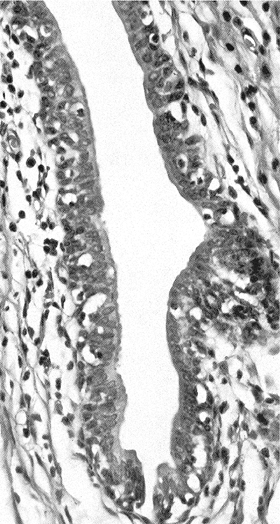 |
Figure 39.5 Bartholin's duct near the gland. Bartholin's duct has a transitional-like epithelial lining, with columnar cells near the surface, similar to the columnar cells lining the gland acini. |
 |
Figure 39.6 Bartholin's duct near its exit to the vulvar vestibule. At this location the duct is lined by stratified squamous epithelium, without surface columnar cells. |
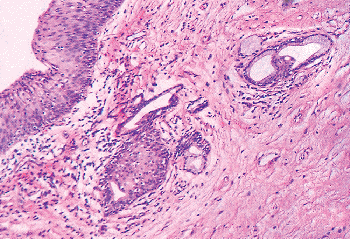 |
Figure 39.7 Minor vestibular glands of the vulvar vestibule. The vulvar vestibular glands are simple glands with a mucus-secreting columnar epithelial lining. Near their exit at the vestibular surface the glands have a stratified squamous epithelium. Vascular vestibular stroma surrounds the superficial gland elements. |
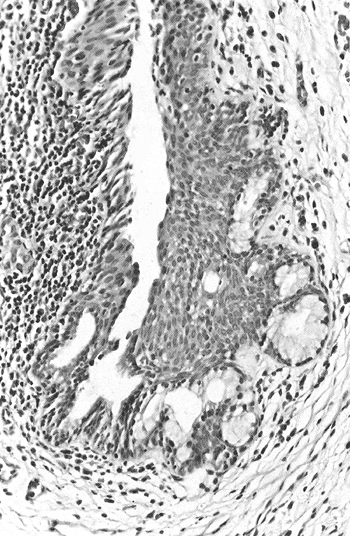 |
Figure 39.8 Vestibular gland with squamous metaplasia near the vestibular surface. Moderate chronic inflammation, consisting predominantly of lymphocytes, is seen adjacent to the gland and is consistent with vulvar vestibulitis. |
Urethral Orifice (Meatus Urinarius)
The urethra has a transitional epithelial lining that merges with the stratified squamous epithelium at the urethral orifice. The periurethral glands of Huffman enter into the urethra throughout most of its length (50). Obstruction or inflammation of these periurethral glands may result in a urethral diverticulum or periurethral abscess. Partial prolapse of the urethra results in a polypoid mass, often referred to as a urethral caruncle. The mucosa may become ulcerated, and the underlying stroma may become inflamed with vascular dilation and engorgement; however, it otherwise retains the normal histology of the urethra.
Hymen
The hymen marks the distalmost extent of the vagina and the most proximal boundary of the vulvar vestibule. The hymen may be imperforate, round, annular, septate, cribriform, or porous (2). On the vaginal surface, the hymen has a nonkeratinized stratified squamous epithelium, which is glycogenated upon estrogen exposure, as seen in women of reproductive age, newborn female infants, and postmenopausal women receiving estrogen therapy. On the vulvar surface the vestibular epithelium appears similar to the vaginal epithelium in women of reproductive age (Figures 39.3, 39.10). The hymenal ring contains some Merkel tactile disks for touch and moderate numbers of free nerve endings, which are pain receptors; the hymenal ring lacks other receptors that are present in the labia majora (51,52).
In rare cases of imperforate hymen, the hymen lacks its normal opening. This leads to accumulation of menstrual exodus in the vagina, resulting in vaginal distension (1) with menstrual products, a condition referred to as hematocolpos. Coitus, or the routine use of intravaginal tampons, results in tears in the hymen, which result in small soft hymenal tags referred to as carunculae hymenales, or carunculae myrtiformes (34,53). On the external hymen and on the
P.989
vulvar vestibule, small papillae may be identified, which are referred to as vestibular papillae. Multiple papillae are seen in the condition known as vestibular papillomatosis (54). Such papillae within the vestibule are generally considered a variant of normal anatomy and are infrequently associated with human papillomavirus. Solitary or isolated asymptomatic papillae on the hymen usually represent a normal anatomic variant (55) (Figure 39.11).
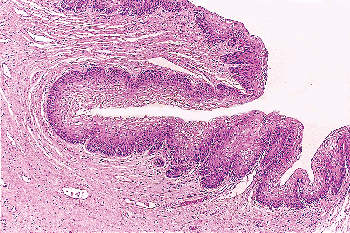 |
Figure 39.9 Vulvar vestibular cleft. The vulvar vestibular cleft has a stratified squamous epithelial lining, similar to the vulvar vestibule. These clefts appear to arise as a result of squamous metaplasia of vestibular glands. |
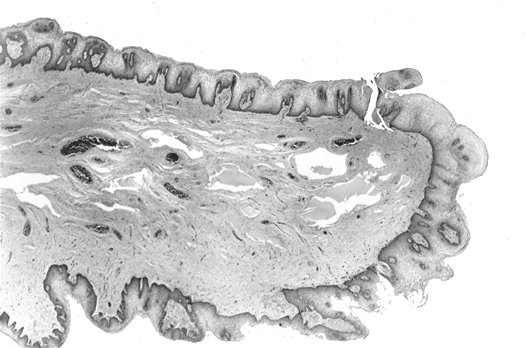 |
Figure 39.10 Cross section of the hymen of a 26-year-old woman. The epithelium of the vaginal (upper) and vestibular (lower) surfaces of the hymen is a stratified squamous epithelium, which is nonkeratinized and glycogen rich. The fibrovascular component of the hymen supports the epithelium. |
Clitoris
The clitoris is the descendant of the embryonic phallus, homologous to the corpus cavernosum of the male penis. It is immediately anterior to the frenulum, at the junction of the labia minora, and it is enfolded by the prepuce. The clitoris measures approximately 2 cm in its long axis and consists of two crura and a glans clitoridis. The crura are composed of erectile tissue similar to that in the corpora cavernosa of the male (3,4). They consist of cavernous veins surrounded by longitudinal smooth muscle, as well as small centrally placed muscular arteries, enveloped by the tunica albuginea. The tunica albuginea is composed of wavy collagen fibers and straight elastic fibers. Peripheral to the tunica albuginea is the loose connective tissue that supports the nerves and receptors of this area. The glans clitoridis is covered with squamous mucosa without glands, rete, or papillae (40,52,56). The cavernous tissue of the corpus spongiosum of the male does not have its counterpart in the clitoris; it is found instead in the vascular erectile tissue of the labia minora (Figure 39.12). The clitoris contains nerve endings in lesser amount than seen in the labia majora, although Pacinian corpuscles are abundant. Peritrichous nerve endings for touch reception are absent. The other receptors are present, although their distribution is highly variable (52). Other touch receptors, namely, Meissner's corpuscles and Merkel tactile disks, are present in reduced numbers in the clitoris, as compared with the labia majora or mons pubis. Pacinian corpuscles, for pressure reception, are present in large numbers (52). The free nerve endings for pain reception are found throughout the vulva and in relatively high concentrations in the clitoris, labia majora, and mons pubis (52). Ruffini's and Dogiel-Krause corpuscles, which may be associated with temperature or sexual sensation, are found throughout the vulva but not in the hymenal ring (52).
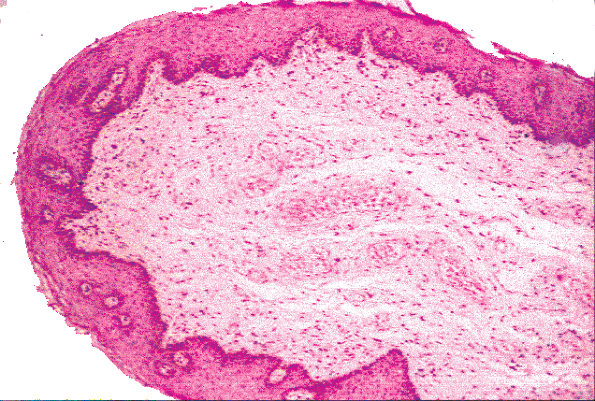 |
Figure 39.11 Vulvar vestibular papillae. The papillae have a stratified squamous epithelial surface and fibrovascular stalks. |
Labia Minora
The bilateral labia minora derive from the embryonic medial folds (genital folds) and lie lateral to the vulvar vestibule and medial to the labia majora, bounded by the
P.990
intralabial sulcus. The epithelium of the labia minora is of ectodermal origin. The labia minora have their male embryologic counterpart in the penile corpus spongiosum (34). The minora measure approximately 5 cm in length and 0.5 cm in thickness; however, their length can vary considerably. The epithelium of the labia minora is of the stratified squamous type; it is not keratinized on its vestibular surface but has a thin keratin layer lateral from Hart's line.
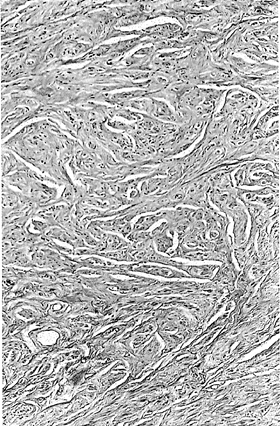 |
Figure 39.12 Erectile tissue of the labia minora. |
Most of the epithelium of the labia minora does not contain skin appendages; however, in some individuals, the lateral labia minora may contain sweat and/or sebaceous glands (56). The epithelium of the labia minora may be somewhat pigmented, especially in lateral and posterior areas (Figure 39.13). Beneath the epithelium is highly vascular, loose connective tissue that is rich in elastic fibers. Posterior and deep to the labia minora are the vestibular bulbs (bulbi vestibuli), which are composed of erectile tissue and are invested by the bulbocavernous muscles. The labia minora contain erectile tissue and thus are highly vascular, yet they lack adipose tissue. The vessels and erectile tissue are supported by a rich elastic fiber component. The nerve endings within the labia majora are similar to those found within the clitoris, yet Meissner's corpuscles and Merkel tactile disks occur in larger numbers than usually identified within the clitoris (52).
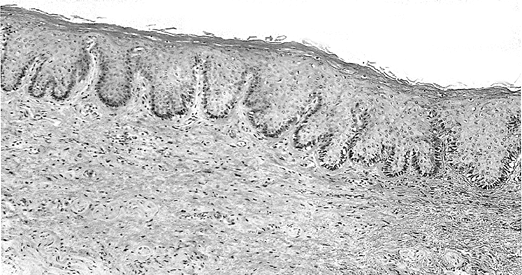 |
Figure 39.13 Lateral labia minora biopsy from a 27-year-old white woman. Within this area, the labia minora contain no skin appendages. The epithelium is pigmented, and melanocytes and pigmented basal epithelial cells are seen in the basal layer. The stratified squamous epithelium has a thinly keratinized surface. Beneath the epithelium, there is an elastic fiber rich stroma without fat or skin appendages. Moderate numbers of small vessels can be seen. Deeper tissue is demonstrated in Figure 39.12. |
Congenital enlargement of the labia minora may occur and may be asymmetrical. Enlargement also may be secondary to irritation, chronic edema or minor trauma. Surgical reduction of the labia minora or local excision for therapeutic reasons does not appear to impede normal sexual function or response; however, excision of the labia minora for female circumcision is associated with introital stenosis, vulvar keratinous cysts, and sexual and urinary dysfunction (8,57).
Labia Majora
The labia majora arise from the embryonic lateral folds (genital folds, labial folds), which arise lateral to the cloacal plate and do not fuse (39). The epithelium is ectodermally derived from the urogenital sinus. The endodermally derived epithelium of the vestibule joins with the ectodermally derived epithelium of the medial labial majora. This junction is apparently at Hart's line, where the epithelium of the medial (inner) labia majora joins the nonkeratinized squamous epithelium of the vestibule (29,30). In the male, the labial (scrotal) folds fuse to form the scrotum. This fusion usually occurs by 74 days of gestation (crown-rump length approximately 71 mm) (39). In the female, the labia
P.991
majora merge with the mons pubis anteriorly and with the perineal body posteriorly. The labia majora lie immediately lateral and parallel to the labia minora, separated by the intralabial sulcus. In the medial posterior positions, the labia majora are bounded by the vulvar vestibule. Laterally, they merge with the inguinal-gluteal folds, which separate the labia from the medial aspect of the thighs. Although minor asymmetry of the labia majora is considered to be normal, marked asymmetry may be early evidence of neurofibromatosis (58). Chronic inflammation, varicosities, edema, Bartholin's cysts, and benign or malignant tumors also may be associated with asymmetry of the labia majora.
Aging changes related to the labia majora include an increase in size of the labia with puberty, primarily related to increased fat within the labia. In addition, there are dramatic changes in hair growth during puberty (see Mons Pubis discussion, below) (59). After menopause, there is a progressive loss of hair follicles and consequent loss of labial hair (60) as well as shrinkage of the labia majora. This is primarily related to loss of fat within the labia (34).
In addition to age-related changes, changes occur in the labia majora that are related to parity. During gestation, the influence of gestational hormones, especially progesterone, results in vascular dilation and stasis within the labia (52). These gestational changes may result in the development of vulvar venous varicosities (61).
Similar to other hair follicles, each follicle of the vulva has a hair root surrounded by the dermal root sheath, which invests the root sheath of the hair follicle. The inner root sheath is composed of an external clear epithelial cell layer (Henle's layer) and an inner granular epithelial cell layer (Huxley's layer). The hair matrix matures to the formed hair of the hair shaft, where the hair has an outer cuticle with a cortex and medulla. The hair papilla is found at the base of the hair root, protruding into and partially surrounded by the matrix of the hair. The papilla is supported by the dermal root sheath (40,56,62,63). Hair follicles are a portion of the pilosebaceous unit, which includes sebaceous glands.
In the labia majora, sebaceous glands can be found with and without associated hair follicles. The sebaceous glands are alveolar and arranged in a lobular manner, vested by collagen fibers. The cells of the sebaceous glands secrete in a holocrine manner, with the more mature cells accumulating sebaceous secretion (sebum) within their cytoplasm. The secretion is released as the cells undergo necrosis. The secretion may be released adjacent to the hair shaft in the pilosebaceous unit or directly to the surface when no hair shaft is present. There are two types of sweat gland: apocrine and merocrine (40,56,62,63). Apocrine glands are tubular and have a columnar secretory epithelium characterized by a prominent eosinophilic granular cytoplasm. These glands secrete by release of cytoplasmic secretion and are associated with scent production. The scent associated with these sudoriferous glands is related to bacterial growth supported by the secretory products (56,62). Beneath the epithelial layer, myoepithelial cells are identified. These myoepithelial cells are arranged about the periphery of the gland, and their contraction promotes expression of the secretory contents from the gland lumen. The ducts of the apocrine glands are similar to those of the merocrine glands but may secrete into the upper hair follicle rather than to the skin surface when present in hair-bearing skin.
The merocrine glands are eccrine glands that produce clear watery sweat. The secretory cells have a pale, slightly granular cytoplasm and an outer layer of myoepithelial cells. The glands are simple and coiled and are found deep to the reticular dermis. The sweat duct is lined by cuboidal epithelium two-cells thick, and the double epithelial cell layer is lost as it joins with the stratified epithelial surface. Unlike sebaceous and apocrine glands, merocrine glands are not significantly stimulated by the sex hormones. [For further discussion on the histology of the skin elements, the reader is referred to Chapter 1 in this volume and to texts on histology (40,56,62,63).]
The epithelium of the posterolateral aspects of the labia majora, peripheral to Hart's line, is thinly keratinized and pigmented (Figure 39.14). At the posterior fourchette, the
P.992
retia are relatively deeper than in the posterior lateral area (Figure 39.15). Pigmented cells are seen at the basal layer in this area (Figure 39.16). A granular layer may be present immediately beneath the keratinized surface (stratum corneum). The granular layer arises from the underlying prickle cell (spinous cell) layer of the stratified squamous epithelium, with the stratum malpighii overlying the basal layer. The basal layer (stratum germinativum) is present immediately adjacent to the basement membrane (35,64). The medial hairless surfaces of the labia majora contain an abundance of sebaceous glands, which end at Hart's line. These glands are not associated with hair-bearing pilosebaceous units and open directly onto the epithelial surface, with a short nonkeratinized epithelium-lined duct joining with the keratinized epithelial surface (Figure 39.17). Sebaceous glands within the labia majora may have a depth of up to 2.03 mm (65). Keratinous (epithelial) cysts may be associated with these sebaceous gland elements (3,57). Sebaceous glands are not found medial to Hart's line (Figure 39.2). At the midportion of the labia majora, hair follicles are associated with the sebaceous gland elements. Hair follicles within the labia majora may be as deep as 2.38 mm (65) (Figures 39.18,39.19). Apocrine and eccrine sweat glands are found associated with the hair-bearing areas of the vulva but are generally absent in the vestibule and medial non hair-bearing areas of the medial labia majora (Figure 39.20). Deeper within the dermis of the labia majora, a delicate muscle layer (tunica dartos labialis) is present. Beneath this layer is a fascial layer that has a prominent elastic fiber component (52). The fascial layer is associated with a prominent adipose layer in women of reproductive age.
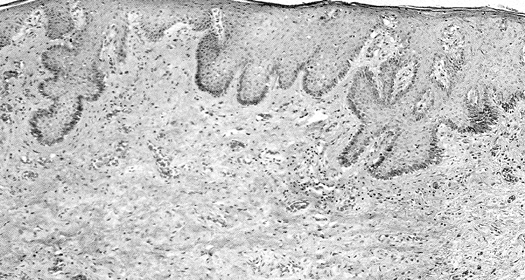 |
Figure 39.14 Posterior medial labia majora of a 27-year-old white woman peripheral to Hart's line. This pigmented portion of the labia majora has a stratified squamous epithelium with a thin keratinized surface. The epithelium has deeper rete ridges than seen in the minora. The dermis is elastic fiber rich and moderately vascular. Sebaceous gland bearing skin was immediately adjacent to this area and has a moderately vascular dermis. |
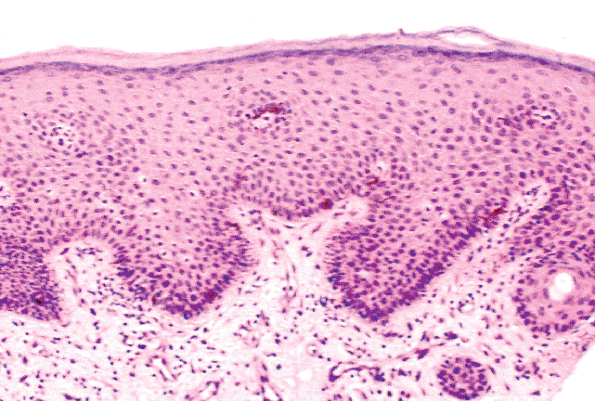 |
Figure 39.15 Posterior vulvar forchette. The epithelium has a thinly keratinized surface, moderately deep rete, and some melanin pigmentation within the basal cells. |
Within the deep anterior labia majora, immediately adjacent to the inguinal canal, the round ligament
P.993
joins with the deep longitudinal smooth muscle layer (cremaster muscle) of the labia majora (52). The round ligament may include entrapped peritoneum (processus vaginalis), which can become cystically dilated and result in a cyst of the canal of Nuck (3). These peritoneum-lined cysts are typically encountered in the anterior portion of the labia majora, adjacent to or within the inguinal canal.
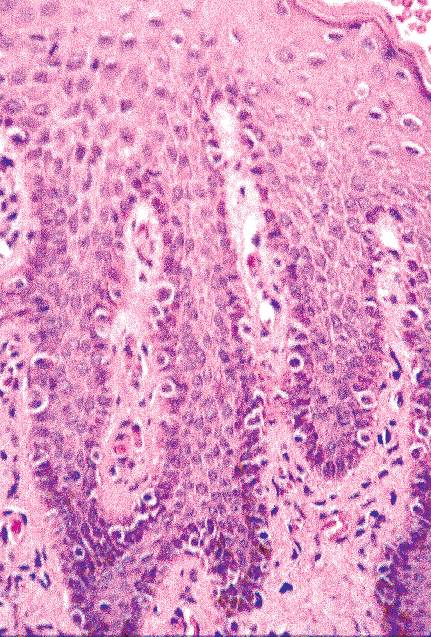 |
Figure 39.16 Posterior perineal body of a 27-year-old white woman. The skin at the perineal body is pigmented, and melanocytes and pigmented keratinocytes are present within the basal layer. The epithelium is stratified squamous epithelium, which has a thin keratin layer. The perinuclear halos present within the epithelial cells are normally seen and should not be confused with koilocytosis. Small clear cells are seen in the epithelial stromal junction within many of the retia. |
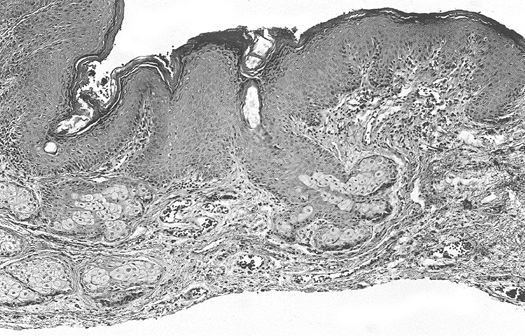 |
Figure 39.17 Labia majora, medial portion, with sebaceous gland elements exiting directly to the skin surface. The epithelium of the medial labia majora has a thin keratin and granular layer. The sebaceous glands may be seen clinically as Fordyce's spots. |
The epithelium of the labia majora is rich in nerve endings and contains touch receptors, including Meissner's corpuscles, Merkel tactile disks, and peritrichous nerve endings (52). Pacinian corpuscles for pressure sensation are present within the fatty layer of the labia majora, as well as within the labia minora, clitoris, and mons pubis. Free nerve endings for pain reception are also present within the epithelium, as well as within muscle cells and blood vessels (51,52). Ruffini's corpuscles are seen throughout the subcutaneous tissue of the labia majora, labia minora, clitoris, and mons pubis. They are absent in the hymen. Their exact function in the vulva is uncertain; however, they may be temperature receptors and/or receptors for sexual stimuli (52). Dogiel-Krause receptors have a distribution similar to that of Ruffini's corpuscles; however, they are present in a relatively smaller concentration in the mons pubis and labia majora (52).
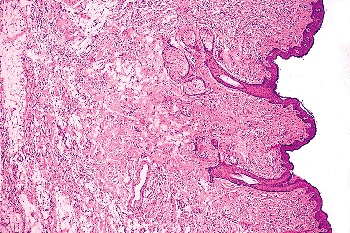 |
Figure 39.18 Labia majora, midportion, with underlying dermis and deep fatty tissue. The thickness of the dermis can be seen in this section of the labia majora. A few deep hair follicles can be seen within the elastic fiber rich dermis. The dermal junction with the deep fatty tissue is irregular. |
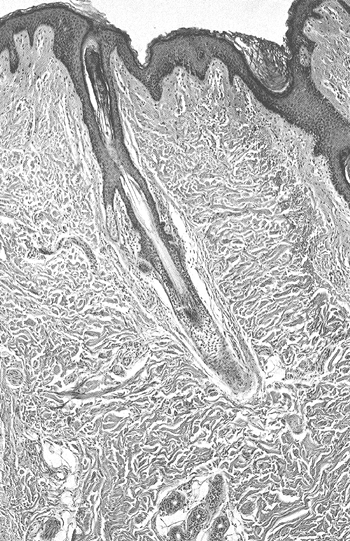 |
Figure 39.19 Labia majora, lateral, with hair follicle and sweat gland elements. The sweat gland duct is seen adjacent to the portion of the hair follicle. |
P.994
 |
Figure 39.20 Labia majora with apocrine glands and sweat ducts adjacent to a hair follicle. Moderate vascularity of the collagen-rich dermis of the labia majora surrounds these sweat gland elements. |
Medial to the labia majora, within the sulcus between the labia majora and minora (sulcus interlabialis), anogenital mammary-like glands are present that may give rise to cysts within the intralabial sulcus; they also may involve the medial aspect of the labia majora. These glands, and the cyst described, are lined with a cuboidal to columnar epithelium with an underlying myoepithelium. The myoepithelial cells are immunoreactive for smooth muscle actin and S-100 antigen, as well as low-molecular weight keratin. The superficial luminal epithelial cells are of an apocrine type, with visible snouts (Figure 39.21). These cells are immunoreactive for low-molecular weight keratin and human milk fat globule antigen. Individual cells are also immunoreactive for carcinoembryonic antigen and S-100 antigen. Estrogen and progesterone receptors have been detected in these cells. Mucus-containing or ciliated cells are not present, distinguishing the cysts of anogenital mammary-like glands from vestibular mucous cysts, M llerian-related cysts or ciliated cysts, or Bartholin's gland. The lack of a stratified squamous epithelium or transitional epithelium distinguishes them from Bartholin's duct cysts, keratinous cysts, or vestibular glandular cysts that have undergone squamous metaplasia (66). There is evidence that these glands are the origin of fibroadenoma, hidradenoma papilliferum, milk cysts, and apparent ectopic breast tissue that have been described in the vulva (rather than being from true ectopic breast tissue) (67).
Mons Pubis (Mons Veneris)
The mons pubis has its origin in the embryonic genital medial cranial swellings (39). The subcutaneous tissue of mons pubis becomes more prominent with the onset of puberty, when there is a progressive increase in fat tissue beneath the mons. There is also a dramatic increase in hair growth of the mons pubis and labia majora.
Aging changes related to the mons pubis include hair growth changes that have been summarized and staged by Tanner in the following sequence (59). Stage 1 is characterized by no visible pubic hair growth. In stage 2, a small amount of pubic-type hair is seen on the midportion of the mons pubis, and some similar hair may be seen on the labia majora. In stage 3, the mons pubis hair growth is more prominent, both in the amount of hair and the coarseness of the hair. In stage 4, the hair growth over the mons pubis is similar to the adult, with the exception that the upper lateral corners of hair growth are lacking. Stage 5 characterizes the adult pubic hair pattern (59). The adult hair growth distribution is reached between the ages of 12 and 17 years (34). There can be substantial variability in the amount and character of the pubic hair (escutcheon) related to racial and genetic factors; however, pubic-type hair growth generally does not extend above a horizontal line drawn between, and 2 cm above, the uppermost limits of the genitofemoral folds (60,68). Hair follicle depth within the vulva is greatest in the mons pubis, where hair follicle depth has been measured up to 2.72 mm (65). The mons pubis is richly endowed with nerve receptor types that were previously described for the labia majora (52).
Lymphatic Drainage
The vulvar tissues drain to lymph nodes in the femoral and inguinal lymph node chains. The anterior labia minora and clitoris drain through channels anterior and superior to these structures to join lymphatics from the prepuce and labia majora. These channels course laterally to inguinal and femoral nodes (69). In some cases, lymphatic channels from a lateral site may drain to the contralateral node group, which has clinical relevance in planning therapy for malignancies of the vulva. The most common site of metastasis from vulvar malignancies are the superficial inguinal nodes. In general 8 to 10 nodes are found in this area, with superior oblique (above the ligament of Poupart) and inferior ventral (between the ligament of Poupart and the saphenous vein and fascia lata) divisions. Midline structures, such as the
P.995
clitoris and the midline perineum, drain bilaterally. A second path of lymphatic drainage from the clitoris involves urethral lymphatics and lymphatics draining the dorsal vein of the clitoris. These channels lead inferior to the symphysis pubis through the anogenital diaphragm to join the lymphatic plexus of the anterior bladder surface. Ultimately, these channels terminate in the interiliac and obturator nodes or course superiorly to the femoral and internal iliac nodes. Deep pelvic nodes are not generally involved unless the superficial inguinal nodes are involved.
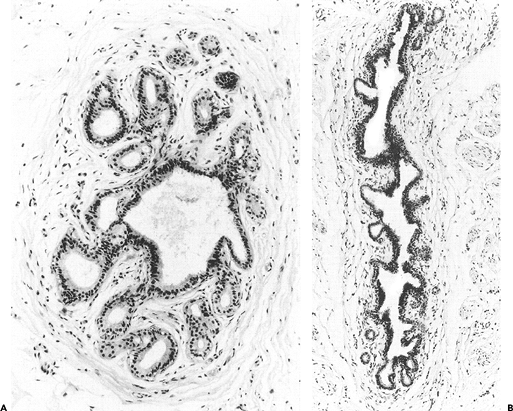 |
Figure 39.21 Mammary-like anogenital gland with main duct (A and B) and small acini (A). The epithelial lining is composed of a two-layered epithelium with underlying myoepithelial cell layer and a low columnar epithelial luminal epithelium. Reprinted with permission from: van der Putte SC. Mammary-like glands of the vulva and their disorders. Int J Gynecol Pathol 1994;13:150 160. |
Sentinel lymph node mapping in the assessment of vulvar carcinoma and melanoma, employing intraoperative lymphoscintigraphy (technetium-99m labelled nanocolloid) with or without blue dye (patent blue V) is gaining in application to assess inguinal lymph node status. Microscopic assessment of the lymph nodes picking up the colloid/dye is performed to plan appropriate lymph node resection related to the vulvar surgery. When nodes are found to be negative by this technique, the patient may be spared radical inguinal-femoral lymphadenectomy (18).
Obstruction of vulvar lymphatics, related surgical interruption, or inflammation (such as secondary to Crohn's disease) may result in lymphangiectasia of the vulva. This condition may present with leakage of clear fluid from the vulva, associated with multiple small, glistening, superficial clustered vesicles on the vulvar skin, resembling frog spawn. Some degree of epithelial and dermal edema is also typically present (70).
Arterial Supply
The major arterial supply of the vulva originates with the superficial and deep external pudendal arteries (branching from the femoral artery) and the internal pudendal arteries
P.996
(branching from internal iliac arteries). The pudendal artery has anterior and posterior labial branches. Circulation to the clitoris is separate and emanates from the deep arteries of the clitoris. The anterior vaginal artery supplies the vestibule and Bartholin's gland areas (3).
Venous Supply
Major venous drainage of the vulva is primarily from the bilateral internal iliac veins, which drain into the external iliac venous system. The internal iliac veins drain both parietal and visceral venous systems. The parietal tributaries of the internal iliac vein include the internal obturator, internal pudendal veins, superior and inferior glutal veins, sciatic vein, and ascending lumbar veins. The visceral branches drain pelvic organs, including the uterine, ovarian, and vaginal venous systems. In a study of this drainage in 79 specimens, a single internal iliac vein was present on the side studied in 73% of the cases; in 29% of the cases, two separate iliac veins drained into the external iliac vein; and, in one case, the internal iliac vein drained directly to the inferior vena cava (71). Vulvar varices are identified in approximately 2% of women seeking care in a vein clinic; such varices correlate with insufficiency of the internal iliac venous system and also involve the tributaries of the internal iliac vein as well as the saphenous vein (71).
Nerve Supply
The major nerves of the vulva are from the anterior and posterior labial nerves. The anterior nerve is a branch of the ilioinguinal nerve, and the posterior labial branch is from the pudendal nerve. The clitoral nerve supply is from the dorsal nerve of the clitoris and the cavernous nerves of the clitoris. Branches of the cavernous nerves, arising from the vaginal nerve plexus, join the clitoral dorsal nerve at the hilum of the clitoral bodies. The dorsal nerve of the clitoral bundle branches from the pudendal nerve. The two clitoral bodies, beneath the pubic arch, separate to form the two clitoral crura. Immunohistochemical studies have demonstrated that the dorsal nerves form two bundles that are extensively distributed along the lateral aspects of the clitoral bodies at the eleven and one o'clock positions but are sparse at the twelve o'clock position. These join distally to form a single clitoral body. The densest nerve groups that enter the glans clitoris are found on the dorsal aspect of the clitoris, with a concentration of nerves under the epithelium of the glans clitoris (72). The vestibule shares the clitoral nerve supply (3,52).
References
1. Haefner HK, Collins ME, Davis GD, et al. The vulvodynia guideline. J Lower Genital Tract Disease 2005;9:40 51.
2. Kaufman RH, Friedrich EG, Gardner HL. Benign Diseases of the Vulva and Vagina. 3rd ed. Chicago: Year Book Medical; 1989.
3. Wilkinson EJ, Xie DL. Benign diseases of the vulva. In: Kurman RJ, ed. Blaustein's Pathology of the Female Genital Tract. 5th ed. New York: Springer-Verlag; 2002:37 98.
4. Ridley CM. General dermatological conditions and dermatoses of the vulva. In: Ridley CM. The Vulva. New York, Churchill Livingstone; 1998:138 211.
5. Spiryda LB, Laufer MR, Soiffer RJ, Antin JA. Graft-versus-host disease of the vulva and/or vagina: diagnosis and treatment. Biol Blood Marrow Transplant 2003;9:760 765.
6. Farage MA, Bjerke DL, Mahony C, Blackburn KL, Gerberick GF. Quantitative risk assessment for the induction of allergic contact dermatitis: uncertainty factors for mucosal exposures. Contact Dermatitis 2003;49:140 147.
7. Nardelli A, Degreef H, Goossens A. Contact allergic reactions of the vulva: a 14-year review. Dermatitis 2004;15:131 136.
8. Thabet SM, Thabet AS. Defective sexuality and female circumcision: the cause and the possible management. J Obstet Gynaecol Res 2003;29:12 19.
9. Janaki VR, Premalatha S, Rao N, Thambiah AS. Lawrence-Seip syndrome. Br J Dermatol 1980;103:693 696.
10. Seely JR, Seely BL, Bley R Jr, Altmiller CJ. Localized chromosomal mosaicism as a cause of dysmorphic development. Am J Hum Genet 1984;36:899 903.
11. Hanna SJ, Kaiser L, Muneer A, Nottingham JF, Kunkler RB. Squamous cell carcinoma of the bladder presenting as vulvitis and cliteromegaly. Gynecol Oncol 2004;95:722 723.
12. Creighton SM, Minto CL, Steele SJ. Objective cosmetic and anatomical outcomes at adolescence of feminising surgery for ambiguous genitalia done in childhood. Lancet 2001;358:124 125.
13. Baskin LS. Anatomical studies of the female genitalia: surgical reconstructive implications. J Pediatr Endocrinol Metab 2004;17:581 587.
14. Lee PA, Witchel SF. Genital surgery among females with congenital adrenal hyperplasia: changes over the past five decades. J Pediatr Endocrinol Metab 2002;15:1473 1477.
15. Crouch NS, Minto CL, Laio LM, Woodhouse CR, Creighton SM. Genital sensation after feminizing genitoplasty for congenital adrenal hyperplasia: a pilot study. BJU Int 2004;93:135 138.
16. Minto CL, Liao LM, Woodhouse CR, Ransley PG, Creighton SM. The effect of clitoral surgery on sexual outcome in individuals who have intersex conditions with ambiguous genitalia: a cross-sectional study. Lancet 2003;361:1252 1257.
17. Chan JK, Sugiyama V, Tajalli TR, et al. Conservative clitoral preservation surgery in the treatment of vulvar squamous cell carcinoma. Gynecol Oncol 2004;95:152 156.
18. Hakam A, Nasir A, Raghuwanshi R, et al. Value of multilevel sectioning for improved detection of micrometastases in sentined lymph nodes in invasive squamous cell carcinoma of the vulva. Anticancer Res 2004;24:1281 1286.
19. Moore RG, Granai CO, Gajewski W, Gordinier M, Steinhoff MM. Pathologic evaluation of inguinal sentinel lymph nodes in vulvar cancer patients: a comparison of immunohistochemical staining versus ultrastaging with hematoxylin and eosin staining. Gynecol Oncol 2003;91:378 382.
20. Moore RG, DePasquale SE, Steinhoff MM, et al. Sentinel node identification and the ability to detect metastatic tumor to inguinal lymph nodes in squamous cell cancer of the vulva. Gynecol Oncol 2003;89:475 479.
21. Yu BK, Lai CR, Yen MS, Tou NF, Chao KC, Yuan CC. Extramammary Paget's disease found by abnormal vulvar brush sampling. Eur J Gynaecol Oncol 2002;23:35 36.
22. Brown HM, Wilkinson EJ. Cytology of secondary vulvar Paget's disease of urothelial origin: a case report. Acta Cytol 2005;49:71 74.
23. Wilkinson EJ, Stone IK. Atlas of Vulvar Disease. Baltimore: Williams & Wilkins; 1995.
24. Mancino P, Parlavecchio E, Melluso J, Monti M, Russo P. Introducing colposcopy and vulvovaginoscopy as routine examinations for victims of sexual assault. Clin Exp Obstet Gynecol 2003;30:40 42.
P.997
25. Bechara A, Bertolino MV, Casabe A, et al. Duplex Doppler ultrasound assessment of clitoral hemodynamics after topical administration of alprostadil in women with arousal and orgasmic disorders. J Sex Marital Ther 2003;29(suppl 1):1 10.
26. Suh DD, Yang CC, Cao Y, Garland PA, Maravilla KR. Magnetic resonance imaging anatomy of the female genitalia in premenopausal and postmenopausal women. J Urol 2003;170:138 144.
27. Deliganis AV, Maravilla KR, Heiman JR, et al. Female genitalia: dynamic MR imaging with use of MS-325 initial experiences evaluating female sexual response. Radiology 2002;225:791 799.
28. Maravilla KR, Cao Y, Heiman JR, et al. Noncontrast dynamic magnetic resonance imaging for quantitative assessment of female sexual arousal. J Urol 2005;173:162 166.
29. Hart DB. Selected Papers in Gynaecology and Obstetrics. Edinburgh, Scotland: W&AK Johnston; 1893.
30. Dickinson RL. Human Sex Anatomy. 2nd ed. Baltimore: Williams & Wilkins; 1949.
31. Benedet JL, Wilson PS, Matisic J. Epidermal thickness and skin appendage involvement in vulvar intraepithelial neoplasia. J Reprod Med 1991;366:608 612.
32. Hu F. Melanocyte cytology in normal skin. In: Ackerman AB, ed. Masson Monographs in Dermatology-1. New York: Masson; 1981.
33. Edwards JN, Morris HB. Langerhans' cells and lymphocyte subsets in the female genital tract. Br J Obstet Gynaecol 1985;92:974 982.
34. McLean JM. Anatomy and physiology of the vulva. In: Ridley CM, ed. The Vulva. New York: Churchill Livingstone; 1988:39 65.
35. MacKie RM. Milne's Dermatopathology. 2nd ed. London: Hodder Arnold; 1984.
36. Goldstein AT, Marinoff SC, Christopher K. Pimecrolimus for the treatment of vulvar lichen sclerosus: a report of 4 cases. J Reprod Med 2004;49:778 780.
37. Gould VE, Moll R, Moll I, Lee I, Franke WW. Biology of disease. Neuroendocrine (Merkel) cells of the skin: hyperplasias, dysplasias, and neoplasms. Lab Invest 1985;52:334 352.
38. Bottles K, Lacey CG, Goldberg J, Lanner-Cusin K, Hom J, Miller TR. Merkel cell carcinoma of the vulva. Obstet Gynecol 1984;63: S61 S65.
39. Robboy SJ, Bently RC, Russell P. Embryology of the female genital tract and disorders of abnormal sexual development. In: Kurman RJ, ed. Blaustein's Pathology of the Female Genital Tract. 5th ed. New York: Springer-Verlag; 2002:3 26.
40. Bloom W, Fawcett DW. A Textbook of Histology. 10th ed. Philadelphia: WB Saunders; 1975:904 905.
41. Rorat E, Ferenczy A, Richart RM. Human bartholin gland, duct, and duct cyst. Histochemical and ultrastructural study. Arch Pathol 1975;99:367 374.
42. Fetissof F, Berger G, Dubois MP, et al. Endocrine cells in the female genital tract. Histopathology 1985;9:133 145.
43. Word B. Office treatment of cyst and abscess of Bartholin's gland duct. South Med J 1968;61:514 518.
44. Pyka RE, Wilkinson EJ, Friedrich EG Jr, Croker BP. The histology of vulvar vestibulitis syndrome. Int J Gynecol Oncol 1988;7:249 257.
45. Friedrich EG Jr, Wilkinson EJ. Mucous cysts of the vulvar vestibule. Obstet Gynecol 1973;42:407 414.
46. Robboy SJ, Ross JS, Prat J, Keh PC, Welch WR. Urogenital sinus origin of mucinous and ciliated cysts of the vulva. Obstet Gynecol 1978;51:347 351.
47. Fowler WC Jr, Lawrence H, Edelman DA. Paravestibular tumor of the female genital tract. Am J Obstet Gynecol 1981;139:109 111.
48. Axe S, Parmley T, Woodruff JD, Hlopak B. Adenomas in minor vestibular glands. Obstet Gynecol 1986;68:16 18.
49. Friedrich EG Jr. Vulvar vestibulitis syndrome. J Reprod Med 1987; 32:110 114.
50. Huffman JW. The detailed anatomy of the paraurethral ducts in the adult human female. Am J Obstet Gynecol 1948;55:86 101.
51. Krantz KE. Innervation of the human vulva and vagina: a microscopic study. Obstet Gynecol 1958;12:382 396.
52. Krantz KE. The anatomy and physiology of the vulva and vagina and the anatomy of the urethra and bladder. In: Philipp EE, Barnes J, Newton M, eds. Scientific Foundations of Obstetrics and Gynaecology. Chicago: Year Book; 1977:65 78.
53. Novak ER, Woodruff JD. Novak's Gynecologic and Obstetric Pathology. 7th ed. Philadelphia: WB Saunders; 1974.
54. Growdon WA, Fu YS, Lebherz TB, Rapkin A, Mason GD, Parks G. Pruritic vulvar squamous papillomatosis: evidence for human papillomavirus etiology. Obstet Gynecol 1985;66:564 568.
55. Bergeron C, Ferenczy A, Richart RM, Guralnick M. Micropapillomatosis labialis appears unrelated to human papillomavirus. Obstet Gynecol 1990;76:281 286.
56. Amenta PS. Elias-Pauly's Histology and Human Microanatomy. 5th ed. New York: John Wiley & Sons; 1987:502 503.
57. Junaid TA, Thomas SM. Cysts of the vulva and vagina: a comparative study. Int J Gynaecol Obstet 1981;19:239 243.
58. Friedrich EG Jr, Wilkinson EJ. Vulvar surgery for neurofibromatosis. Obstet Gynecol 1985;65:135 138.
59. Tanner JM. Growth at Adolescence. 2nd ed. Oxford: Blackwell; 1962.
60. Barman JM, Astore J, Pecoraro V. The normal trichogram of people over 50 years. In: Montagna W, Dobson RL, eds. Advances in Biology of Skin. Vol. IX. Hair Growth. Oxford, England: Pergamon Press; 1969.
61. Gallagher PG. Varicose veins of the vulva. Br J Sex Med 1986;13:12 14.
62. Geneser F. Textbook of Histology. Philadelphia: Munksgaard/Lea & Febiger; 1986:616 617.
63. Leeson CR, Leeson TS, Paparo AA. Textbook of Histology. 5th ed. Philadelphia: WB Saunders; 1985:485 486.
64. Zelickson AS. Electron Microscopy of Skin and Mucous Membranes. Springfield, IL: Charles C Thomas; 1963.
65. Shatz P, Bergeron C, Wilkinson EJ, Arseneau J, Ferenczy A. Vulvar intraepithelial neoplasia and skin appendage involvement. Obstet Gynecol 1989;74:769 774.
66. van der Putte SC, van Gorp LH. Cysts of mammary-like glands in the vulva. Int J Gynecol Pathol 1995;14:184 188.
67. van der Putte SC. Mammary-like glands of the vulva and their disorders. Int J Gynecol Pathol 1994;13:150 160.
68. Lunde O. A study of body hair density and distribution in normal women. Am J Phys Anthropol 1984;64:179 184.
69. Parry-Jones E. Lymphatics of the vulva. J Obstet Gynaecol Br Commonw 1963;70:751 765.
70. Handfield-Jones SE, Prendiville WJ, Norman S. Vulval lymphangiectasia. Genitourin Med 1989;65:335 337.
71. LaPage PA, Villavicencio JL, Gomez ER, Sheridan MN, Rich NM. The valvular anatomy of the iliac venous system and its clinical implications. J Vasc Surg 1991;14:678 683.
72. Yucel S, De Souza A Jr, Baskin LS. Neuroanatomy of the human female lower urogenital tract. J Urol 2004;172:191 195.
- Chapter II Information Search on the Internet: A Causal Model
- Chapter V Consumer Complaint Behavior in the Online Environment
- Chapter VII Objective and Perceived Complexity and Their Impacts on Internet Communication
- Chapter VIII Personalization Systems and Their Deployment as Web Site Interface Design Decisions
- Chapter XVI Turning Web Surfers into Loyal Customers: Cognitive Lock-In Through Interface Design and Web Site Usability